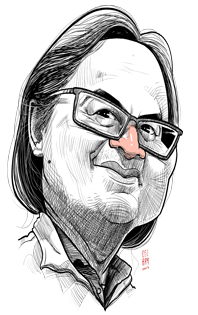Rachman, Noer F., Laksmi A. Savitri, and Mohamad Shohibuddin (2009) "Questioning Pathways Out of Poverty: Indonesia as an Illustrative Case for the World Bank's Transforming Countries", Journal of Peasant Studies 36(3):621—627
Abstract
The World Development Report 2008 uses Indonesia as an illustrative case for what it calls ‘transforming countries’. The main argument of this paper is that the three pathways out of poverty (commercially-oriented entrepreneurial small-holder farming; rural non-farm enterprise development, and out-migration) prescribed by the Report should be theoretically and empirically questioned because of the possibility of a reverse consequence: the perpetuation of poverty in Indonesia.
Keywords: pathways out of poverty; global market; capitalism
[I]f capitalism is thrown out of the door, it comes in through the
window.
Braudel (1982), Civilization and Capitalism
This
paper will critically discuss some claims that the World Development Report
2008 (henceforth, WDR 2008) makes based on its reading of the Indonesian
case. In this short commentary we will not examine the applicability of its
linear theory of agriculture-for-development, which reminds us of Rostow’s
‘stages of economic growth’, by correcting the data it uses for Indonesia,
or adding new data, nor will we criticise the vision that the Report offers,
although we believe that vision to be erroneous.[1] Our goal is straightforward: to explore how capitalism produces new
poverty through the very same pathways that the Report proposes as ways to
exit from rural
poverty.
Indonesia, according to the Report, falls into the category of ‘transforming countries’, in which ‘agriculture is no longer a major source of economic growth, contributing on average only 7 percent to GDP growth, but poverty remains overwhelmingly rural’ (p. 4). It almost qualifies as ‘urbanised’, a category in which ‘agriculture contributes even less to economic growth, 5 percent on average, and poverty is mostly urban. Even so, rural areas still have 45 percent of the poor, and agribusiness and the food industry and services account for as much as one third of GDP’ (p. 4). Indeed Indonesia, ‘already in the transforming category in the 1970s, further reduced the share of rural poverty’ (p. 30) in the subsequent decades. Indonesia supported the agriculture sector ‘indirectly through regular devaluations of the exchange rate that provided incentives to its producers of agricultural tradables, and directly through investments of some windfall oil revenues in rural infrastructure, irrigation, agricultural credit, and fertilizer subsidies’. As a result, ‘$1-a-day poverty declined from 47 percent in 1981 to 14 percent in 1996’ (p. 35).
The
WDR contains twelve references to Indonesia, all of them claiming a
successful process of transition, as evidenced by a decline in rural poverty
between 1980 and 2001, rapid growth in the non-farm share of rural
employment in 1990– 1995, and migration to small and intermediate cities
that may offer greater potential than larger cities for poorer rural
households. The Report conveys a clear message that Indonesia escaped
poverty by design, through policies such as increasing agricultural
productivity, investment in agricultural/rural infrastructure, and
state-sponsored capital lending by the Bank Rakyat Indonesia. These
policies, according to the WDR, oriented the rural poor towards three
pathways: (i) entering commercial farming by integration into the market for
global food and agricultural products, (ii) engaging in waged labour, and
(iii) outmigration from the rural economy. But WDR 2008 does not explain
which layer of the rural poor has actually entered the global market and
accumulated gains, how the connection with the market is constructed, and
how outmigration has operated as a strategy for different segments of the
rural population.
The
potential ‘downsides’ of the three pathways need to be explored if we are to
understand whether the transformation of Indonesia has indeed increased the
wellbeing of the poor, as the Report claims, or perpetuated their poverty.
The Report has no systematic way of grasping these ‘downsides’, since it
lacks a concept of capitalism as a set of relations that produce poverty as
well as wealth (Mosse 2007, 9); indeed, we could not find the word
‘capitalism’ in the Report. We share with Mosse and others the perspective
that treats poverty as a consequence of social and economic relations,
rather than a static condition. Thus ‘poverty cannot be eradicated . . . on
the contrary poverty is continually being created and recreated under the
institutions of capitalism’ (Harriss-White 2006, 1241). In order to
understand poverty dynamics, it is necessary ‘to examine the relations
between the dominant and dominated classes, groups and individual, as it is
through their multiple linkages that livelihoods of the poor contribute to
the enrichment of the wealthy and thus to the poor’s continuing misery’ (Kay
2005, 327, Kay 2006).
Further,
we need to understand capitalism ‘historically, structurally, and
spatially’, and to situate Indonesia within ‘wider fields of power’, placing
the ‘global’ within the ‘local’ (Roseberry 2002, 77). Since integration into
global markets produces differential opportunities and constraints, and the
poor tend to have less access to favourable ‘pathways’, integration risks to
deepen inequality and uneven development.
For full and free access: https://drive.google.com/drive/u/0/folders/1ELWgF7oQ9R_ZpMVgx0fTo_6cbH4IiYPN
[1] Akram-Lodhi (2008, 1160) argues the Report ‘offers a vision . . . that will consolidate the corporate food regime and the establishment of agrarian capitalism across the worlds of global agriculture’.


No comments:
Post a Comment